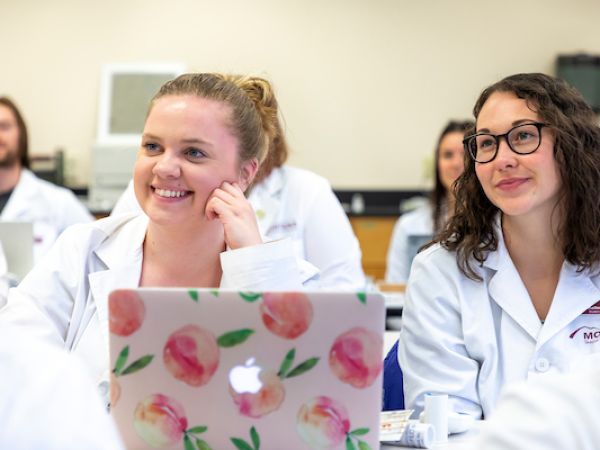
Workforce Development
Training Programs
Our training programs include the following principles
- Utilize input and feedback from workforce partners to ensure training meets the current needs
- Use distance and accelerated training models for equitable access and quick entry into the workforce
- Skills and case studies based so that Ñý¼§Ö±²¥ get real-world, applicable training to enter the workforce prepared
Current Training Programs
-
The Montana Preceptor Training is an online, self-paced course for healthcare preceptors to provide thoughtful, tailored support that will help improve retention and job satisfaction among healthcare workers in our state.
Participants will develop the following skills from this training:
• Increase skills and confidence in precepting the next generation of healthcare providers
• Improve new healthcare worker retention -
This training will prepare trainees to become behavioral health care managers in a clinical setting that offers integrated behavioral health. The Integrated Behavioral Health Care Manager will work directly with a primary care provider(s) to deliver brief behavioral health interventions in the primary care setting. The training will cover the SAMSHA-HRSA integrated behavioral core competencies to ensure that the trainees are well prepared to provide behavioral health services in a primary care/integrated behavioral health setting. The training will include 145 hours of skills-based + case-studies instruction in conjunction with on-the-job training. Participants who complete this program are eligible for 6 credits of prior learning in the . If you are interested in having an employee complete this training, contact Portia O'Connell.
-
This professional development experience is a self-paced, online training to provide high school science teachers with the following:
- Educate high school science teachers about the requirements for a dual-credit Anatomy & Physiology course.
- Demonstrate how the Montana Science Standards/NGSS can be incorporated into this type of course.
- Demonstrate how to incorporate the 2019 National Health Science Standards into this type of course.
- Explain the difference between high school credit, college credit, dual credit, and career and technical education (CTE) coursework.
- Develop and implement an inquiry-based science curriculum based on best practices in learning and Anatomy & Physiology.
- Provide resources on Anatomy & Physiology, CTE, NGSS, and Inquiry-based instruction.
Once completing the training a teacher will receive 40 CEUs and a complete BIOH 104/105 curriculum to use in their classroom. This course does not cover Anatomy & Physiology content, teachers are expected to already have a background in Anatomy & Physiology. This training can be used to meet some of the requirements for a Montana Class 4A CTE license.
to Register.
Dual-Credit Instructor Requirements:
- Master's Degree in the content area or a Master's of Education + 9 graduate credits in the content area
- Some teachers may be eligible for a temporary waiver for this requirement
- Montana Class 1,2, or 4 license
- Undergraduate coursework in Anatomy & Physiology
-
Unlock your potential as a project leader in healthcare or any industry with the PMI® Authorized On-Demand PMP® Exam Prep—the official online training from PMI designed to help you master essential project management skills and confidently prepare for the Project Management Professional (PMP)® certification exam. This engaging, self-paced course features five interactive modules that immerse you in real-world scenarios across diverse sectors, including healthcare, so you can practice applying proven project management principles and agile methodologies in practical settings. Developed and validated by certified PMP® professionals, this comprehensive program covers the latest agile and hybrid approaches, aligns with the PMP Exam Content Outline, and fulfills the 35-hour training requirement for the exam application. Whether you are a mid-level project manager, a healthcare professional, or anyone seeking to advance their career and meet PMP® certification requirements, this course is your proven path to exam success. Sign up today and take the next step toward your PMP® credential. Project management is one of the top skills Montana employers are seeking, with local companies increasingly valuing professionals who can lead teams, manage complex projects, and deliver results in dynamic environments.
-
The Health Professions Essentials Microcredential Program provides Ñý¼§Ö±²¥ from high school through the underclassmen college level with a solid introductory knowledge/skills base for entering either a health professions degree program or an entry-level healthcare career. The coursework for this program is a combination of credit/non-credit courses. The for-credit coursework is offered as either dual-credit or online options. This coursework would also qualify many Ñý¼§Ö±²¥ to enroll in entry-level healthcare certification programs such as CNA, Medical Coding, and EMT. To get started contact the Missoula College Dual Enrollment Program.

-
The UM OHRP and Missoula College partnered to develop a . This program is geared toward high school Ñý¼§Ö±²¥ interested in the health profession field. All of the courses in this program are offered as dual-credit options so Ñý¼§Ö±²¥ can complete them either in their high school or online through Missoula College. The program is made up of health science foundational and/or pre-requisite coursework for the UM/Missoula College health profession programs. Contact the Missoula College Dual Enrollment Program to learn more.
Apprenticeships
What are Apprenticeships?
An apprenticeship program trains skilled workers by pairing coursework (related technical instruction) with tailored on-the-job training. Apprenticeship programs require an apprentice to complete a minimum of 2,000 hours of on-the-job training while taking related coursework and demonstrating industry-recognized competencies. The Apprentice is paid a wage while completing the apprenticeship program and, at the end of the program, earns a certificate/certification.
Apprenticeship Benefits:
- Apprenticeship programs increase the retention of employees. 94% of apprentices are still employed 6 months after completing the apprenticeship program.
- For every dollar spent on an apprenticeship program, there is a $1.50 return.
- Employers reduce costs when training an employee because they can utilize a wage scale based on mastery of competencies
- Employers get to train the apprentice (employee) to meet the needs of their facility
- Employers hire the apprentice so they have an employee from day one instead of waiting until after someone completes the training to hire them
- Apprentices receive targeted supervision and mentorship throughout the course of the apprenticeship so they feel more confident in their skill set and ability to practice in their field
- Apprentices earn an industry-recognized certificate and/or certification at the end of the program
- Some apprenticeship programs include college coursework so apprentices can earn a college degree at a reduced cost
- Apprenticeship programs are an effective recruitment tool
OHRP Apprenticeships
The OHRP is a certified apprenticeship intermediary with the Montana Department of Labor & Industry. The apprenticeship programs sponsored by the OHRP focus on high-demand professions that are capable of being stacked into more advanced career pathways. The OHRP either develops the related technical instruction portion of the apprenticeship or partners with another provider. The RTI will use an accelerated training model, and/or will be offered online using a distance education model. We use an iterative process for designing and implementing apprenticeship programs to ensure we are meeting our partners' workforce needs. In addition to providing or supporting the RTI for the apprenticeships, we provide technical assistance to our partners participating in the program.
OHRP Role/Responsibilities:
- Register the apprenticeship program with the Montana Department of Labor and Industry
- Develop a trade schedule for each program
- Manage all paperwork and data collection requirements for each registered apprenticeship program
- Provide technical assistance to each employment site
- Provide/facilitate RTI for apprentices
- Provide apprentice supervisor training
Apprenticeship Employment Site Role/Responsibilities:
- Post apprenticeship position, interview/hire apprentice, employ apprentice
- Coordinate with OHRP on necessary paperwork and data collection
- Provide supervision to the apprentice
- Support the apprentice in completing the required RTI
- Provide on-the-job training that meets trade schedule standards
Current Apprenticeship Programs
-
145 hours of online instruction prepares trainees to serve as the behavioral health care manager in a variety of mental health settings. In conjunction with the 145 hours of didactic instruction, trainees will complete 2,000 hours of on-the-job training in a primary care or mental health setting. It is suggested that participants have a background in human services and/or behavioral health.
-
630 hours of remote instruction provided through UM-Bitterroot prepares trainees to serve as LPNs in a variety of healthcare settings. In conjunction, with the 630 hours of didactic instruction trainees will complete 2,000 hours of on-the-job training in a primary care setting. This training is for credit so Ñý¼§Ö±²¥ will be required to pay the cost of tuition for the program, which is 40 credits. Students may qualify for funding through Alluvion Health Center to offset the costs of completing this apprenticeship.
-
The LPN to RN apprenticeship program at the Ñý¼§Ö±²¥-Missoula College is designed to provide licensed practical nurses (LPNs) with a comprehensive pathway to advance their careers and become registered nurses (RNs). This program offers a unique blend of theoretical knowledge and practical training, equipping participants with the skills and expertise needed to excel in the healthcare industry. Through a combination of online instruction and hands-on experience in clinical settings, apprentices gain a deep understanding of nursing principles, patient care techniques, and healthcare management. With a focus on mentorship and professional development, the program fosters growth and prepares individuals to deliver high-quality care in diverse healthcare environments. Students may qualify for funding through the UM-OHRP and Alluvion Health Center to offset the costs of completing this apprenticeship.
-
The pharmacy technician apprenticeship program at the Ñý¼§Ö±²¥ offers a dynamic opportunity for individuals aspiring to enter the pharmaceutical field and pursue a rewarding career as a pharmacy technician. Through a structured curriculum combining 400 hours of online instruction and practical experience, apprentices gain essential knowledge and skills in medication dispensing, inventory management, customer service, and pharmaceutical regulations. Under the guidance of experienced pharmacists and technicians, apprentices have the chance to apply their learning in real-world pharmacy settings, honing their abilities and building confidence in their roles.
-
Students complete 2,000 hours of on-the-job training while also completing an academic training program in surgical technology. After this surgical technologist apprenticeship, Ñý¼§Ö±²¥ are eligible to sit for certification.
-
-
The Montana Teacher Apprenticeship Program (MTAP) follows a competency-based model in alignment with the InTASC Model Core Teaching Standards and Learning Progressions for Teachers 1.0. Apprentices are hired as paraprofessionals and will work alongside master teachers as they learn the art of teaching. Each apprentice must demonstrate mastery of teaching competencies over a minimum of 2,000 hours of on-the-job learning (OJT) and at least 144 hours of related instruction. The RTI will utilize a competency-based format and be provided by at least one of the MUS EPPs. The program integrates progressive wage increases and maintains an apprentice-to-mentor teacher ratio of 1:1.
